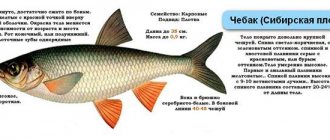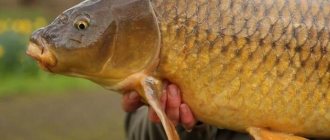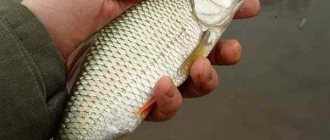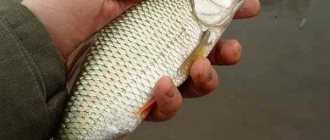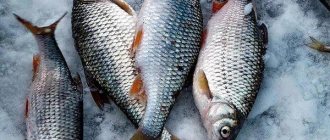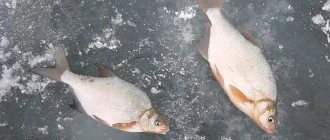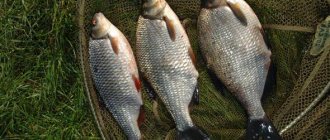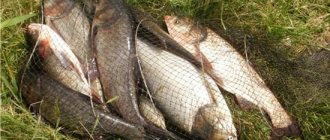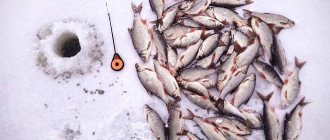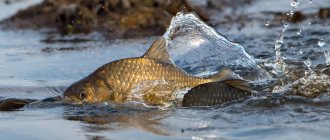The best bait for roach. How to make bait for roach with your own hands?
Roach is a schooling fish of the carp family, widespread in our latitudes, found in almost every body of clean water.
This inhabitant of the river depths is very popular among fishermen, especially during periods of its greatest activity. It constantly moves around the reservoir in search of food, so properly selected bait for roach plays a significant role in the fishing process. As you know, the result of any fishing depends not only on the gear, the characteristics of the place, weather conditions and bait, but also on the correctly selected bait. Its role is to attract and keep fish in the desired area. A properly selected mixture can attract inhabitants of the depths at a distance of up to several hundred meters.
Bait for roaches in autumn
Like other fish, with the arrival of autumn, roach accumulates fat reserves for the long winter. It is in winter, due to a lack of oxygen in the water, that fish activity decreases and the body is forced to switch to replenishing nutrients from fat reserves.
When preparing for roach fishing in the fall, the angler must take into account the quality of the feed mixture and add more ingredients high in protein and fat to the complementary food.
One of the important components of autumn bait for roaches is cereals. The cereal contains many nutrients that will be necessary for roaches during the winter. Cereals may include pearl barley, rolled oats, barley, and peas. In addition to the composition of fats and proteins in these cereals, they attract roaches with their odors, which is important when feeding a future fishing spot.
Another important basis is the addition of aromatic substances to the autumn feed mixture for roaches. These substances include anise drops, hemp drops, vanilla and other fragrant ingredients. However, it must be remembered that in the fall the roach’s sense of smell is more developed than in the summer or spring, and the high consistency of aromas in the water can scare away the fish. Therefore, it is better not to use flavorings in autumn bait for roaches at all.
Read: The best winter baits for catching bream
In addition to cereals and aromatic substances, breadcrumbs and crushed cake are added to the autumn bait for roaches. The breadcrumbs in the bait add viscosity to the mixture, and the cake has a pleasant smell, to which the roach reacts positively. The cake also contains a large proportion of fat, which is accordingly an additional source of nutrition for fish in the autumn.
To prepare autumn bait you will need:
- Cereals 200-300 grams. It is desirable that the bait be more rich; you can mix several types of cereals, for example pearl barley and rolled oats.
- Breadcrumbs – 100-150 grams. Crackers can be bought at a special fishing store or made yourself.
- Cake – 50 grams.
- Other impurities. These include sunflower oil and bloodworms, which are also an additional source of food in the feed mixture.
- Priming.
Cereals must be boiled or steamed in boiling water. Add crackers, cake and other ingredients to the resulting porridge. After this, you need to mix everything thoroughly and add soil to give the bait density. After this, make a dense lump that should not fall apart in your hand. If the lump is dense enough, then the feed mixture is ready for use. If not, then by adding soil, give the bait the desired viscosity.
Read: Advantages of homemade bait
In the autumn, the role of bait for catching roach is very important, as the fish prepare for winter and actively move around the reservoir in search of food. And as you know, roach is a schooling fish and it is impossible to keep it in place without feeding. Taking this into account, the fisherman needs to know that the success of autumn roach fishing depends on bait.
Where to look for roach
The favorite habitats of this fish are coastal areas with rich aquatic vegetation. In such places it is not difficult to find food, and you can hide from predators. On rivers, roach avoids the current; you should look for it in quiet areas with a “return” or in creeks.
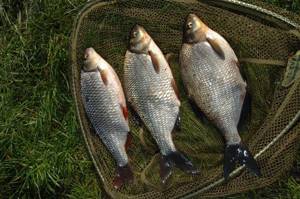
In early spring, it prefers to stay near the steep banks of reservoirs, especially where melt water flows, carrying various seeds and insects. Closer to summer, roach spawns on warm shallows overgrown with reeds and water lilies. In hot weather, it sinks to the depths, coming out to the shore to feed in the morning and at sunset. In autumn and winter, schools of this fish stay in their homes, but when the weather changes, they walk and feed in the shallows and in reed thickets.
What do they use to catch and what do they use to lure roaches?
The bait should be selected based on the roach’s natural diet. Its natural food is aquatic plants, larvae, insects that have fallen into the water, and small crustaceans. Bloodworms and maggots have proven themselves to be the best when fishing for roach. It also bites well on worms, dough, boiled wheat and bread.
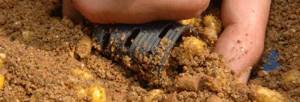
The choice of bait for roach should depend on the following factors:
- season;
- Times of Day;
- type and size of the reservoir;
- flora and fauna of the reservoir;
- weather conditions
In early spring, the best bait for this fish are maggots, worms and insect larvae. During this period, she is the most hungry and exhausted by the winter cold, so protein food is simply necessary for her. But in the summer, the roach’s appetite subsides. It is often caught even with green thread algae wound on a hook. Groundbait for roach, like bait, should contain its natural food, taking into account the time of year.
We make bait for spring with our own hands
Spring is the most catchy time of year for many fish species, and roach is no exception.
It is in the spring, when the ice melts from reservoirs and the flow of oxygen increases, that the fish become more active. Roach during the spawning period , which runs from April to mid-May, is very inactive and its bite is practically absent, but after spawning, in order to regain strength, the roach begins to actively feed. It is during this period that many anglers can enjoy catching this wonderful fish. In spring, roaches bite on any bait, such as bread, bloodworms, maggots, dough, worms and others. But at this time, when the roach is actively looking for food, it moves around the reservoir and so that the angler does not have to follow the school of roach, you can use bait, which will keep the school in the place desired by the angler.
Spring bait should differ from bait of other seasons in that this bait contains a large number of plant ingredients, since the roach restores strength and energy after a long winter. But you need to know that high-calorie ingredients can quickly saturate the roach, so it is better to exclude bloodworms and maggots from the bait.
An important task of feeding roach in the spring is to lure and keep fish at the fishing point. And when making it, you need to adhere to three factors, namely: the visual factor, in which a cloudy trail of bait remains in the water, which will lure the roach. The aroma factor, which will make the roach stay in the fishing spot, and the taste factor, which will also contribute to the success of keeping the school in the right place.
The first method of preparing spring bait
After preparing the bait, store it in a tightly closed, airtight container.
Aromas and smells tend to evaporate. Bait in spring should consist of the following ingredients:
- Rolled oats or pearl barley – 200-300 grams .
- Breadcrumbs – 100 gr .
- Powdered milk – 2 teaspoons .
- Cake – 150 g .
- Anise or hemp oil flavoring
- Corn or wheat flour – 100 g .
Rolled and pearl barley, which is the main ingredient in the bait mixture for roaches, must be boiled and allowed to brew. After this, add breadcrumbs and corn flour and mix thoroughly. Next, cake and flavoring are added to the bait and all this is infused for about two hours. After this, the bait acquires a smell that will lure the roach and keep it at the fishing site.
Second method (for the lazy)
There is a more modern way of feeding roach in the spring. This bait contains all ready-made components and is sold in specialized stores. These baits most often use ground rolled oats , barley , millet and breadcrumbs, which are quite suitable for spring roach fishing. The bait also contains sunflower or flax grains. But when purchasing such bait, it is necessary to fill it with warm water (or from a reservoir, on the spot) and add various types of flavorings so that the luring effect is most successful.
Features of choosing bait
When going for roach, you can freely buy a ready-made bait mixture in a store or market, but for some reason most fishermen still prefer a homemade product. This, firstly, saves money, and secondly, it is simply impossible to ideally select a purchased bait for a specific body of water, time of year and fishing location. Therefore, bait for roach, prepared with your own hands from selected ingredients, will make fishing more effective.
Under no circumstances should you use universal bait. Although the roach is a fish of the carp family, its feeding method is somewhat different than that of its relatives. In other words, store-bought bait for roach and bream, carp, crucian carp, etc. differs in its properties. This is due to the fact that all these fish have different feeding horizons. If carp, bream and crucian carp feed from the bottom, then roach looks for food in the water column and on its surface.
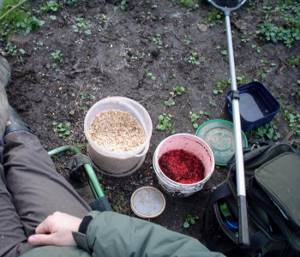
In this regard, the bait for roaches should not sink instantly, but dissolve in the water as soon as it gets into it. It is also advisable that the mixture does not contrast too much with the color of the bottom - this will alert the fish.
What are the features of bait for roach?
Roach is a representative of the class of carp fish, but roach bait is somewhat different from carp bait. And the point here is that the process of feeding these fish varies greatly.
If carp tries to find food for itself at the bottom of reservoirs, digging in the silt deposits of the bottom, then roach prefers to feed in the water column of the reservoir, as a result of which complementary food for carp, which will settle to the bottom of the reservoir, will not be suitable for roach.
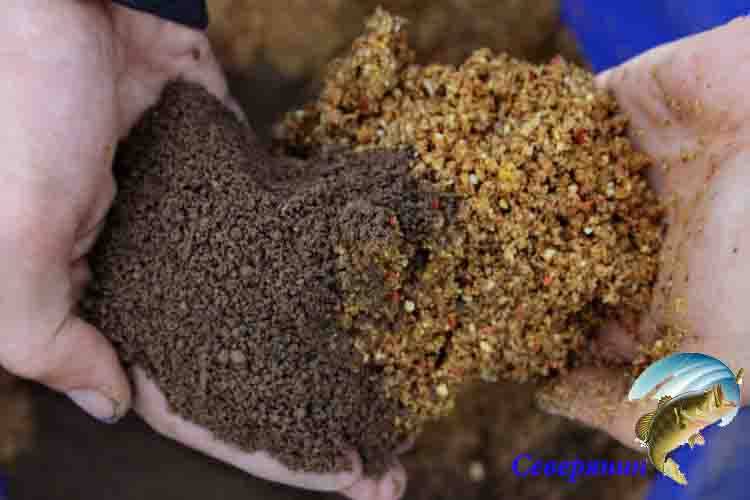
Many anglers note the circumstance in which fishing for roach will be very successful if the roach bait is made in such a way that it seems to float in the water column of the reservoir, as if clouds are floating across the sky, and the same should be the case with roach bait.
It should also be noted that it is necessary to prepare roach bait that is more similar in color to the bottom of the reservoir. If the reservoir is muddy, with silt at the bottom, then the roach bait should be darker in color; if the bottom of the reservoir is sandy, then the roach bait should be made in lighter shades.
Composition of bait for roach
Standard bait for roach should include the following main components:
- base (steamed breadcrumbs);
- boiled cereals or legumes (rye, wheat, peas, lentils);
- ground cake (most often sunflower);
- maggots, crushed worms, bloodworms (for winter) and algae (for summer);
- flavorings;
- clay.
Breadcrumbs are most often used as the basis for bait for roaches. They swell well and dissolve in water, and also have an excellent smell. It is recommended to use boiled wheat, rye and legumes as part of a mixture for fishing on the current.
The best aromas for attracting roaches, which are used in various baits, are:
Clay in the bait plays the role of a gluing and weighting element, and also makes it possible for the bait to reach the right place without crumbling.
Recipes for preparing bait for roach
For the spring period, the following recipe for making bait for roaches is most suitable - take cake or ground sunflower seeds, add either rolled oats or any other oatmeal. You should also add ingredients of animal origin, and some crushed breadcrumbs. And, of course, a little anise, vanilla and cumin. All this is mixed and during the fishing itself a little reservoir soil and water are added.
For the summer period, the following bait for roaches is most suitable - you should take boiled millet, add cake or sunflower seeds. Add some hemp seeds, oatmeal or oatmeal cookies, you also need to add some ingredients of animal origin and milk powder, and add pond soil and water.
In the autumn, we make the following bait for roaches - take chopped maggots or worms and bloodworms, add a little reservoir soil and water, this is the most productive bait for roaches in the fall.
For the feeder, the following bait recipe for roach is most suitable - take boiled millet, mix in a little breadcrumbs, ground biscuits, add just a little corn flour and oatmeal, you should also add wheat bran, add a little cocoa for flavor.
If roach fishing is carried out on the current, then you should do this - take ground biscuits, add a little breadcrumbs and bran, a little cumin and maggots and worms, add pond soil and water.
The best bait for roach
The range of baits for roach is quite wide, but it is impossible to choose the best one without recommendations based on your own experience. However, there are mixtures that, over the years on the market, have truly earned trust due to their effectiveness:
These baits are aimed specifically at roaches and their culinary preferences. But they can also be used for catching bleak, verkhovka and chub.
To choose the best bait, you should definitely take into account the time of year, because the nutrition of the fish changes depending on the temperature, pressure and the presence of certain foods in the reservoir.
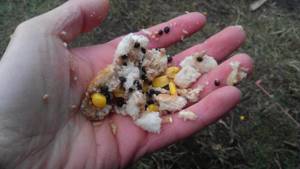
Bait for roaches in winter and late autumn, in addition to plant components, must include small or chopped bloodworms, a worm, as well as powdered milk and cocoa to form a “dusty” cloud. In cold weather, it is also advisable to add branded flavors with the smell of spices, which will attract fish even under ice.
Bait for roaches in summer may contain crushed algae. During this period, it is good to use flax or hemp seeds, as well as crushed leaves of nettle, mint, and basil as attractants.
DIY bait for fishing for bream roach crucian carp
bait for fishing for bream, roach, carp, crucian carp with your own hands , but you can also buy it.
Before going fishing, many fishermen wonder how to make good bait for fishing, because the weight of the cage at the end of fishing depends on it. In this article you will learn about what aromas and smells some types of fish like.
For fishing nowadays, various flavoring additives are used for bait. There are a huge number of scents. By type they are divided into dry and liquid. With their help, the desired aroma of the bait as a whole is achieved. There are also flavors that are intended for attachment, they are called dips. The nozzle, which is treated with dip, once in the water, is distinguished by its spectacular

fragrant and flavorful spot. All the huge variety of tastes and aromas can be divided into several types: 1. Herbs and spices. 2. Creamy and caramel. 3. Nut and fruit. In addition, each type of fish has its own smells. Some of them can attract any fish, others only one, for example bream, roach, etc. After reading this you probably thought it was pretty hard, but it's actually quite simple. To find out what taste and smell the fish prefer in your pond, follow what you read below.
Bait flavors for bream

The aroma of anise for bream is unrivaled, followed by coriander; our grandfathers and great-grandfathers also used them. Also good aromas for catching bream are matting and dill. Depending on the preferences of the bream in the specific reservoir chosen, there is pepper (black and red). If the bream likes the aroma of pepper in your pond, you will never be left without a catch. The smell of garlic works a little worse on bream, but even if it is suitable for a reservoir, you will not know how to bring the fish home. In summer, when the water reaches 24-25 degrees, try using the scent of dill. Your surprise will know no bounds. Ideal flavors for bream include caramel, vanilla, biscuit, cream, and milk. These bream scents work best when the weather is cool. The bites on such days are more intense when using these scents. From the fruit group, the scent of strawberries works great. On cool days, bream flavors such as pineapple and banana work well. Although they are not familiar to bream in our reservoirs, they are nevertheless good at collecting bream in the right place. From the nut group, ground nuts or cake are a good way to attract bream. More and more often, fishermen use the aromas of almonds, hazelnuts and peanuts when catching bream. They are equally effective not only in the warm, but also in the cold season. You can also read about bream fishing tips.

Fragrances for roaches
From the caramel-cream group, the smells of milk chocolate, baked milk, and cheese are excellent for attracting roaches. These scents for roaches are universal and can be used at any time of the year. It has never been observed that these aromas had a bad effect on the roach’s bite. From the fruit group of aromas, the scent of melon is suitable for roaches. Even though she doesn't know it, it works great. In order to effectively catch roaches on warm days, the smell of melon is indispensable. On cold days, the scent of tangerine works great for roaches. The tangerine scent must be handled carefully; if you add too much of it, the bait for catching roach will be spoiled. From the nut group, the scent of coconut works well for roaches. The smell of coconut attracts roaches only in the warm season.
You can read about how and what to catch roach here.
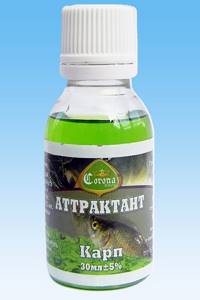
Groundbait flavors for crucian carp and crucian carp
Crucian carp and carp are fish that can be combined into one group. The thing is that these are closest relatives; they are also found side by side in bodies of water. So, what aromas do carp and crucian carp like? From the group of spices, carp and crucian carp prefer vanilla, cinnamon, garlic, pepper (red and black), and anise. They can be added to bait in large quantities. From the caramel-cream group, crucian carp and carp prefer bait with the smell of chocolate, biscuit and other milk aromas. Absolutely all scents from this group are suitable here. From the fruit group, the smells of melon, strawberry, pineapple, blackberry and plum are very attractive to carp and crucian carp. From the nut group, the best bait smells are hazelnuts and peanuts. Basically these are two smells that carp and crucian carp like. Of course, there are exceptions; here you need to experiment on a specific body of water. In addition to the aromas listed above, the smells of hemp and corn also work well, especially for catching roach and carp. The smell of peas and honey works very well for carp. Peas are also good for baiting bream. When fishing for carp, seafood aromas (shrimp, crabs, mussels and others) are also very often used. These odors are of course very specific and are used exclusively in cold water. You need to be careful with seafood smells for carp fishing, because if the carp doesn’t like the smell, the fishing spot will need to be changed. When catching perch with a worm or bloodworm, you can treat the bait with a dip with the smell of garlic; the perch is simply delighted with this smell.
You can read about how to catch carp using corn and how to cook it here.
You can treat any baits with dip, as they are designed for all types of baits, from bloodworms to corn. The main thing is that the fish become interested in this smell. You will find out very soon after casting whether the fish liked the aroma or not. If the fish did not like the smell that was applied to the bait, there will be no bites for much longer until the smell of the dip disappears. Finding flavors these days is not difficult, the only catch is money. If you don’t have a lot of money, then I advise you to refrain from purchasing it altogether; cheap flavors and low-quality dips for baits will have a subtle smell. A good quality dip or flavoring for bait should smell at a distance of 10 meters
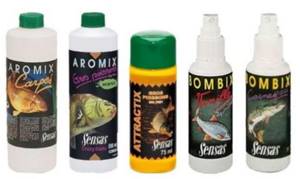
Is it possible to mix different scents?
Smells can and should be mixed. So, a combination of hazelnuts and anise, almonds and milk works well for bream. Good aromas for roach include cinnamon and cheese, coconut and corn. For crucian carp, flavors of strawberry and garlic. For carp, the aroma of honey with banana, pineapple with black pepper. Agree, some smells, to put it mildly, do not go together with each other, but, nevertheless, when mixing these smells, the result is excellent. Remember, fishing requires constant experimentation. We will be glad if you share your successful experiments in the comments.
Read further:

Do-it-yourself bait for roaches in summer
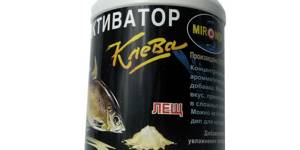
Winter bite activator for catching bream crucian carp roach
Do-it-yourself bait for roach
Bait for roach at different times of the year should have its own composition, which is most suitable for its natural diet in a given period. Here are some popular recipes.
For spring before spawning:
- breadcrumbs – 200 g;
- fried buckwheat – 200 g;
- powdered milk – 50 g;
- chopped bloodworms or worms – 50 g;
- anise flavoring – 5 g;
- clay or river sand.
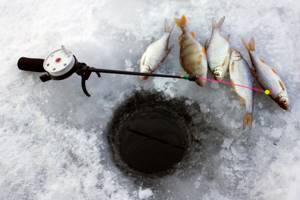
- breadcrumbs or ground crackers - 200 g;
- boiled rye – 200 g;
- “Hercules” porridge – 100 g;
- hemp seeds – 20 g;
- filamentous algae – 50 g;
- makukha (sunflower cake) – 100 g;
- small (feed) maggot – 30 g;
- clay or river sand.
- breadcrumbs – 150 g;
- biscuit – 150 g;
- rye bran – 100 g;
- feed maggot – 30 g;
- bloodworm – 20 g;
- cumin – 3 g;
- clay.
- breadcrumbs – 200 g;
- sunflower cake – 50 g;
- bloodworm or worm – 100 g;
- cocoa or milk powder - 3 tablespoons;
- flavoring (pepper, cumin, coriander) – 2-3 pinches.
Seasonal Recipes
The key rule regarding the production of bait for roaches is to place maximum emphasis on adding plant components, for example, algae, in the summer, and on animals (worms, maggots, etc.) in winter.
Depending on the time of year, it is better to use the following recipes for cooking:
Spring
Main ingredients included:
- breadcrumbs – 150 grams;
- buckwheat – 150 grams;
- milk (dry powder) – 3 tablespoons;
- worms, bloodworms – 40–50 grams;
- flavoring (preferably honey or cinnamon) – 1 teaspoon;
- clay;
For preparation you need:
- Fry the buckwheat in advance. Pour the cereal into a frying pan without adding any oil and fry over low heat for 10 minutes (be sure to stir occasionally).
- in a bowl or other container .
- Worms or maggots are finely cut with a sharp knife and then placed in a bowl.
- On the shore of the reservoir, clay is taken (or river sand can be used) and added to a container with bait, everything is mixed thoroughly.
- Add flavoring and mix again.
- is added (from a local reservoir);
- are made .
Summer
Ingredients:
- breadcrumbs – 150 grams;
- rye or wheat – 150 grams;
- hemp seeds – 15 grams;
- cake – 100 grams;
- seaweed – 40 grams;
- worms – 40 grams;
- river sand;
To prepare you need:
- Cook wheat or rye in advance. You need to put the rye (or wheat) in a bowl, pour in half a liter of warm water, close the lid tightly and leave in a dark place overnight. In the morning, pour everything into a saucepan, bring to a boil, and then cook for 5 minutes over low heat.
- Place boiled rye , crackers, hemp seeds, cake into a container and mix thoroughly.
- Finely chop the worms or maggots and pour them into a bowl.
- On the shore of the reservoir, take algae, cut it and add it to the bait.
- Take river sand (clay is allowed) and mix with the prepared ingredients.
- Add flavoring and stir.
- Add a small amount of water (from a local reservoir);
- Make small balls.
Autumn
Main components:
- breadcrumbs – 150 grams;
- bran – 150 grams;
- maggot – 50 grams;
- worms – 40 grams;
- cumin – 2 teaspoons;
- clay;
For preparation you need:
- Rinse the bran , place in a small saucepan, add water and cook for one hour over low heat.
- Place the prepared bran and breadcrumbs into a container and mix everything.
- Chop worms and maggots.
- Add them to the main mass and mix again.
- On the shore of a reservoir, take clay or river sand, add to the bait, add caraway seeds and mix thoroughly.
- Add a small amount of water (from a local reservoir);
- Make balls.
Winter
When fishing with a jig and adding bloodworms, the following bait mixture works well:
cake
Required components:
- breadcrumbs – 250 grams;
- cake – 50 grams;
- worms – 100 grams;
- milk (dry powder) – 20 grams;
- pepper and coriander - 2 teaspoons;
Preparation:
- in a separate bowl . Mix everything.
- Chop the worms and add to the contents of the bowl.
- Near a river or lake, add flavoring to the bait and mix.
- Add a small amount of water (from a local pond).
- Make balls.
Preparation of bait
Before you make bait for roaches, you need to select the ingredients in the right quantities. Cereals or beans are pre-boiled or steamed, and then ground in a meat grinder. Dry ingredients must be ground to a powder state.
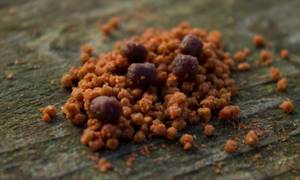
Homemade bait for roach, as well as store-bought bait, is mixed directly at the fishing site using water from the reservoir where the fishing will take place. This will rid the mixture of foreign odors that may alert or scare away the fish. Liquid store-bought flavors are added last.
Groundbait ingredients
Bloodworms activate roach biting, especially in spring and autumn
Different fishing conditions require special bait components.
So, when fishing in reservoirs frequented by fishermen , where enough food of any kind gets into the water, it is better to use bait based on food bloodworms and soil taken from the shore. Compositions based on soaked sweet cookies work well.
For fishing in the current, standard bait based on fine-grained breadcrumbs or grain bran is required. These components quickly erode in water, creating a delicious cloudy trail. The next important ingredient in the mixture is the flavoring. But you should achieve a soft and alluring smell, avoiding an overdose. To add viscosity, you need to add soil taken from the same reservoir. Such food will not alarm roaches.
Feeding methods
The kneaded mixture is formed into balls, the size of which depends on the conditions present. If there is no current and the bottom is hard and level, it is better to use small lumps. In cases where the current is fast, the best option would be balls measuring 5-8 cm in diameter.
To throw bait to the fishing spot, you can use several methods, depending on the distance and the equipment used:
- manually;
- using a “rocket”;
- using a special slingshot;
- using a feeder (when fishing on a feeder).
Experienced fishermen feed the fishing area several days before fishing. This allows the fish to get used not only to the look and aroma of the mixture, but also to a certain area of the reservoir. This solution significantly increases the efficiency of fishing.
In winter, when fishing from ice, at shallow depths, the roach is fed with pinches in such a temporary manner that 300-400 g of the mixture should be enough for the whole day. If the depth is more than 5 m, then the best option would be to use a feeder. When winter fishing, you should not feed the roach with a large number of bloodworms, especially just one - this will certainly attract schools of perch or ruff.
Flavors for crucian carp
crucian carp
. This is a very capricious fish. And with its preferences it causes surprise among fishermen. Garlic, yogurt, kerosene - this is an incomplete list of crucian carp “delicacies”. Abroad, fishermen have become adept at luring crucian carp with the honey aroma and its pronounced sweet smell.
Branded store-bought baits are very effective, but are expensive, so the fisherman has to make them himself.
There are dry and liquid baits. Moreover, bait with a scent is called “dip”. Dry mixtures are usually sprinkled on bait (worms or other living creatures) the day before fishing. In this case, you can take one type of powder or mix several. Garlic, turmeric, and vanilla are often mixed.
Liquid dips are more convenient as they immediately saturate the bait. They consist of different oils, in approximately the same proportions - sunflower, garlic, fish oil, liquid vanillin. Corn oil has the weakest odor; very often it serves as the basis for a liquid dip. A few drops of essential oil with a strong odor can be added to such liquids, as it enhances weak aromas.
Some features of the manufacture and use of bait
In order for fishing to be most effective and not disappointing, it is also important to take into account the following nuances:
- when preparing bait, you should not overuse flavorings - the pungent smell frightens roaches no worse than any predator;
- You should not use old (stale) sunflower cake, as well as other components that have a musty smell;
- bait for roaches in summer should contain a maximum of ingredients of plant origin, and in winter – of animal origin;
- the amount of food in excess of the norm will distract the fish from the bait;
- It is better to feed the area in small portions, with an interval of 15-30 minutes.
Bait for roaches in winter.. About strong aromatization
Roach is perhaps the only fish for which vegetable bait is generally prepared in winter (all sorts of porridges, store-bought mixtures, crackers, etc.). For ruffe, perch, and even for other “white” fish (bream, silver bream, white-eye, etc.), bait is usually not prepared - fishermen feed all these fish. an ordinary bloodworm. I just poured bloodworms into the feeder, lowered it to the bottom - and it was done.

Ruffs, perches and even white bream will probably soon swim up to such tasty bait. But the roach is not. The love of roaches for plant bait has long been noticed. And if you want to catch a roach from the ice, then you need to stock up on plant bait (and not bloodworms, which the ubiquitous small brushes and perches will probably immediately snatch up).
Flavorings for roaches
Roach
. Noisy and heated discussions arise around her preferences. Vanilla is called a special aroma “for roaches”. This fact is no longer in doubt. But nevertheless, industrial flavors with a pure vanilla scent are not produced. Vanilla flavoring is sold separately and is added manually. It is curious that the aroma of vanilla is not at all similar to ordinary vanilla from the store. This seasoning, if used for bait, will not give a rich aroma. After all, you can’t put too much of it. Special vanilla is added in the amount of 100 grams per 1 kg of bait. The fish are so attracted to this smell that a large amount of vanilla does not repel it at all. But this applies to warm water in the summer season. In winter, other substances are used. It has also been noticed that roaches bite well on coriander. This seasoning has an interesting property - bait balls thrown into a pond quickly “shoot out” spicy pieces
Anise is an excellent and undeniably effective supplement. It generally has a sharp, pleasant spice aroma. And its properties improve digestion and cause appetite in the inhabitants of the reservoir. That’s why anise is included in roach bait mixtures. These include specific flavoring additives, which are used a little less frequently - with the taste of chocolate, caramel, etc. Bream. This fish has a classic set of aromas that work flawlessly. These are cloves, cinnamon and fennel. They have a strong smell, aroma, and also stimulate better digestion of food in fish. Spicy additives are always very effective. There is an opinion that bream also loves sweets. That’s why you should take confectionery-themed flavorings. But for some reason, bream don’t like fruity ones.
But we will now touch on one interesting point - the aroma of the bait
As you know, for vegetable baits there are all sorts of liquid and other flavorings (with the taste of anise, vanilla, especially for roach, bream, carp, etc.). There they stand, sold at fishing counters in jars, bottles and other containers. All these bottles and jars have a dosage written on them - which must be followed when adding flavoring to the bait, so that... Never overdo it! Otherwise, as many say, we will scare away the fish. However. Recently, practice has shown that you should not be afraid to overdo it with flavoring. We won't scare away the fish. And what’s most interesting is that, on the contrary, the bite often improves when the dose is increased.
Many people are afraid of it - but in practice it does not harm fishing at all
Many fishermen are very afraid of adding too much flavoring to their bait. Of course, not just anyone, but the manufacturers of these very flavors themselves often warn against this. For example, instructions are usually written on a bottle of flavoring: the proportion according to which the flavoring should be added to the dough (1 cap per 100 g, 2 caps per 100 g and other proportions). And there is a lot of talk about the idea that this is not possible under any circumstances. “overdo it” with the aroma.
Indeed, in this case, the fish will smell this terrible, cloying aroma, it will be taken aback, and it will immediately spread out in different directions. They only saw her. That is, we will simply scare away the fish with too strong an aroma. Interestingly, for some reason, a too weak aroma scares few people, and neither flavoring manufacturers nor authors of fishing magazines usually give any warnings about it.
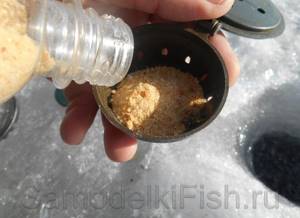
So fishermen are afraid to overdo it with flavoring in the bait. Such a fisherman takes a bottle, carefully unscrews the lid (cap), carefully pours the odorous liquid into the cap and pours it into the dough. And so he pours exactly as many caps into the dough as are supposed to be there according to the instructions. Fishermen do exactly the same thing with all sorts of powdered flavorings - pour them one by one in accordance with the instructions: according to the specified proportion. The main thing is not to overdo it. Why are they doing that? Yes, right. So as not to worsen the fish bite.
But. As practice shows, fishermen’s fears in this regard are in vain. In practice, many fishermen themselves, and many presenters of fishing TV shows, out of curiosity, simply set themselves the following task - to kill the bite of fish with a flavoring agent. And what do you think? Yes, the fishermen didn’t succeed. The bite usually didn’t get worse at all. And the same thing usually happens when fishing. No matter how much flavor we add to the bait, it doesn’t spoil the fish’s bite.
Bait for roach and various tackles
When using bait for roach, you should take into account various nuances, for example, such as the gear with which it will be caught. After all, bait directly depends on the choice of gear, since you need to calculate its viscosity, friability, necessary components, as well as the percentage of these components in order to make the bait ideal for fishing.
Bait for float fishing
Roaches, in most cases, feed in the upper or middle layer of water. Therefore, if the roach bait falls like a stone to the bottom, it will not be of any use. It should create a cloud of turbidity, which will attract fish. To do this, you need to add leavening agents to the bait, such as sand or components that will create a cloudy cloud falling to the bottom. This effect can be obtained by adding a special commercial bait that has this effect to the bait. Usually this bait is called “Geyser” or “Vulcan”, but there may be other names. You can add very little of this bait, literally a couple of bites, and it will do its job perfectly, raising a cloud of turbidity along with your main bait, attracting roaches.
If you want to do without purchased bait, then an analogue for a similar effect would be powdered milk or semolina. If the place is shallow or the fish is kept on the surface, then the balls of bait should break when falling. When the fish is in the middle layers, the balls should disintegrate on the way to the bottom.
Groundbait for bottom fishing
When fishing with a bottom roach, you catch it together with other fish. Its targeted fishing with such gear is possible only in reservoirs where there are a lot of roaches or in shallow waters where large fish are afraid to enter. The bait must have sufficient viscosity to stay in the feeder when casting, and will sink along with it to the bottom. But at the same time, once it reaches the bottom, the food should gradually collapse and release the feeder. To do this, you can add bloodworms or maggots to it. With their movement they attract fish and at the same time gradually loosen the bait.
On the contrary, the catches are better
And here we will say one thing unexpected for fishermen - catches from an overdose of aroma not only do not deteriorate, but also... are improving! A common sight when fishing. We lower the bait into the hole, the roach is slowly attracted to it, and is slowly caught. But as soon as we add flavoring to the bait,... The roach is starting to bite better! And even more - as soon as we pour in a “horse” dose of all sorts of aromas (yes, we can even make a cocktail out of them), and... yes: the bite gets even better! No matter how much flavor we add to the bait mixture, the bite is much more likely to improve than to get worse.

Photo by Shmel-09/E1-fishing
When adding flavorings to bait, we are taught to measure them with caps, to carefully ensure that not a single extra gram is poured into the bait. But. in fact, there is nothing wrong with the fact that we “from the heart” sprinkle flavoring into the groundbait mixture or into homemade dough. And the fish often really like this dose. The roach's bite is weak, weak, but as soon as you add enough flavoring, the bite immediately improves.
We can summarize what has been said this way: an underdose of flavoring in bait will have much more unpleasant consequences than an overdose. Never be afraid to overdo it with flavor in your bait.
Vladislav Ivanchenko – Especially for Homemade FISH, Ukraine, Kyiv
Commentary from the editors of the site SamodelkiFISH
The conclusions about the benefits of strong aromatization seem highly controversial to us, as fishermen who have been fishing in winter for many years. But, as it turned out, NONE of us have NEVER conducted a pure experiment on the use of STRONGLY, specifically strongly flavored bait in ice fishing for roach.
Therefore, we cannot categorically declare that this statement is incorrect, and perhaps even harmful. Although we have a strong opinion among fishermen, and us, about the dangers of strong aromatization of plant bait, and after reading this material it has not changed. The only thing we count on is feedback from readers of our site, practicing fishermen, about PERSONAL EXPERIENCE and conclusions drawn from it.
What smells and tastes does bream like?
Proper baiting of bream allows you to get a big catch - this fact is known to any experienced fisherman. There are many recipes, but, based on the conditions and time of year, each angler uses his own version. There is no universal composition, since the reservoirs for fishing are different, and the food supply differs depending on the season. But the fisherman needs to know what bream likes from smells in summer, spring, autumn and winter. The time of year is always taken into account by anglers to achieve efficiency and excellent results.
What flavors does bream like?
Many fishermen say that bait for bream should be sweet. Taking this factor into account, they add sugar or honey. In addition, there are many flavors that attract fish:
Natural scents in the form of thyme or garlic work well. The latest scent gives excellent fishing results and a stable catch. This is the basic part of the possible odors, but the taste of fish changes depending on the season.
The basis of any complementary food for bream is cereal grain, as well as peas or beans. Additionally, oatmeal and breading are used. From live complementary food, bloodworms, maggots or worms are isolated. To enhance the smell, mix all the ingredients with milk or egg powder, cocoa.
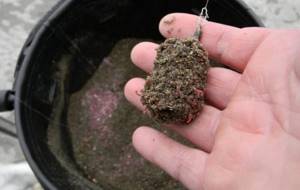
In summer
In summer, freshwater fish prefer vegetable bait. For example, with the arrival of July, you should make food from steamed grains. Pearl barley and buckwheat, peas or millet are recommended.
Summer flavors include:
The addition of garlic or dill is allowed, but this smell also attracts carp and crucian carp. It is not recommended to include animal additives in food in summer, but can be added in minimal quantities.
in autumn
With the onset of autumn, the fish becomes more careful, careful, and by the end of the season its activity decreases. To attract bream, you need to try to choose the right fishing location. Complementary feeding should be based on cereals with the addition of live food, but odors should be reduced as much as possible . It is recommended to add fennel, cinnamon or cloves. Such additives help stimulate the digestive system, attracting prey. In autumn, fruit flavors are excluded.
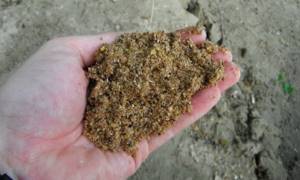
in spring
In spring, bream actively move in the water to find food after winter. As a result, they respond well and go to formulations containing live bait (bloodworms, maggots or worms). The recipes are based on the use of breadcrumbs, to which you add clay or soil located near a reservoir. Among the flavorings, it is preferable to choose vanilla, sugar and fruit additives. Some fishermen like to use caramel or chocolate to increase their catch. For fruit baits, strawberries and cherries are suitable.
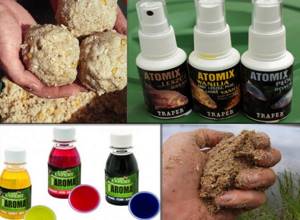
If fragrances are used excessively in the spring, the fish will simply be scared away, and fishing will be ineffective.
in winter
Good fishing in winter is provided by complementary foods such as peas and anise. Both scents are suitable for attracting prey. However, given that in cold water any smell spreads weakly, experts advise adding to the bait:
- Vanilla is the favorite scent of bream and other types of fish.
- Citrus fruits - give a stable catch.
- Strawberry juice.
- Coriander has a distinct and pungent scent, perfect for winter.
- Garlic.
In addition to the “favorite” flavors of fish, it is important to understand the characteristics and follow the rules for preparing bait.
How to choose bait for roach
Homemade cereals, bread and bran can be dangerous for the ecology of the reservoir. In the summer, the products quickly turn sour and poison the fishing area, which becomes uninteresting to such fastidious prey as roach. Industrial mixtures are safe and after a few hours completely dissolve in water without any residue, do not pollute fishing areas and do not sour.
The fish is schooling and if you get it interested in bait, you can return home with a rich catch. Its preferences largely depend on the time of year, and the choice of taste, color and smell of bait determines the season. Dietary features and preferences are also taken into account. Roaches can react to food both at the bottom of the reservoir and on the surface of the water, so floating bait is often used for it, which creates a small fragrant cloud.
Qualities of the best bait for roach:
- Fine grinding, regardless of the composition of the mixture, a homogeneous structure is more interesting for nutrition;
- The aroma attracts and attracts the flock, the stronger and sweeter the smell, the greater the catch;
- The color is selected based on the transparency of the water, bright for cloudy and dark for clear;
- Floating food, the trail of which attracts roaches from long distances.
In summer, fish prefer fruits and berries, in winter, saturated fatty foods, in autumn and spring they react to sweet and spicy aromas. Greens and vanilla are considered a universal choice at any time of the year.
Manufacturers often make formulations in different combinations, which will certainly interest the fish, but seasonal preferences are also taken into account. In cold water, odors spread less easily and a stronger aroma is needed. In the warm season, a low-fat mixture is necessary so that the fish does not get full ahead of time and go to rest.
How to prepare bait for bream
Any bait is best done in the evening if fishing is planned in the morning. However, the ingredients must be mixed right near rivers and reservoirs. Regardless of the recipe, you need to add a little clay, sand and water . Form the bait in the form of balls, and throw several pieces immediately into the pond before fishing to attract fish. From time to time you need to bait the bream with fresh bait, but its size should be significantly reduced so as not to scare away the prey.
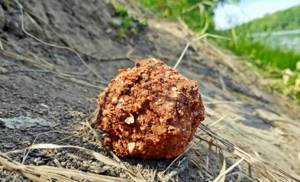
Main components
Based on practical information, a list of products that bream prefers as bait has been compiled. To make it at home, you will need to take as a basis:
- Pea porridge - fish love this flavor very much, and the culture itself is considered the basis of the whole mixture. It is necessary to cook the peas to such a consistency that they are soft, but do not mash into puree. The porridge should have a pleasant smell.
- Breadcrumbs are a universal product suitable for summer or autumn bait. It is characterized by a pronounced odor and acts as a basic component. You can buy a ready-made product in a store or make it yourself from dried bread.
- Pearl barley - suitable for bream if it is boiled. Before cooking, be sure to rinse and do the same after cooking. This will prevent the cereal from sticking together.
- Millet is an equally effective basis for bait, but the porridge should crumble. During cooking, rinse the cereal and control the consistency during cooking. It should not be a single piece; such food is not suitable for bream.
- Bloodworms are the best animal bait, but they can arouse interest in small fish, which will not provide the opportunity to get a large catch.
In fishing stores you can find ready-made mixtures containing the above products, or you should prepare the bait yourself. You just need to select the necessary ingredients and follow the manufacturing recipes.
What can I add?
To the base products you need to add other ingredients that increase the bream’s interest in bait. The main ones:
- peanut;
- corn flour;
- sugar;
- cake;
- roasted crushed sunflower seeds;
- cookie;
- dill.
Video: Preparing bait for bream
If you use dill, then chop it and add 2-3 tsp. per 1 kg of base mixture. Liquid store-bought flavorings are also used, but in minimal quantities. The main aromas are vanilla, strawberry, banana . Before use, the liquid is diluted with water to reduce the concentration and simplify mixing.
Proportions of ingredients
| corn grits | 600 grams (3 standard glasses) |
| ground roasted sunflower seeds | 200 grams |
| semolina | 100g |
| breadcrumbs or ground biscuits | 400 grams |
The end result will be a loose, slightly muddy bait. Ground roasted seeds perfectly adjust the mechanics specifically for autumn roach. Semolina will give a slight dregs.
If you prepare everything correctly, such bait comes out without any problems even from the feeder. But this effect is only possible with crumbly corn grits.
How to cook corn grits
Unlike carp or large crucian carp, where a little plasticity is welcome, in bait for roach it is simply unacceptable. Especially in the fall, when the water is already getting colder.
- Pour water into the pan, at least 6 times more than corn grits.
- Place on the fire, add a little salt (1 tablespoon), wait for it to boil.
- Pour the cereal into boiling water.
- Cook for exactly 8 minutes.
- We rinse. You can rinse in a colander under running cold water (if the cell is too large, you can add gauze). Or in the pan itself, by constantly changing the water and stirring.
Seeds, breadcrumbs or cookies
With store-bought breadcrumbs, everything is obvious; they are already in the right condition. But it’s convenient to grind the cookies in a meat grinder. If the quantity is small, you can use a coffee grinder.
Any cookie will do.
A coffee grinder is also needed to break the seeds, which must be roasted.
Mixing the ingredients
First, mix the boiled cereal with breadcrumbs or cookies. And only then add semolina with seeds. With this sequence we will avoid clumping.
Since the porridge is only made from water, the roach bait will be slightly moistened. Taking this into account, it is recommended to prepare such a mixture the day before fishing, so that the porridge does not spoil.
To form balls, during fishing you need to add a little water, but be careful.
For a feeder feeder, moisture is not required at all if you are fishing for roach in stagnant water. When there is a flow, you can add a little soil and a little water.
A selection of inexpensive float rods is here - click.
Back to
“Bait for roaches”
Bait recipes
Any fisherman should know several recipes for preparing bream bait. It is important to have “secrets” in stock for certain conditions and seasons. This rule will allow you to get a good result, a big catch. In addition, choosing the right recipe guarantees that you will catch big fish.
For fishing in still water and currents
A simple bait recipe helps catch bream in still water:
- breadcrumbs - 300 g;
- crushed seeds - 200 g;
- bran - 300 g;
- millet porridge - 300 g;
- chopped coriander - 2/3 tsp;
- dry clay - as a binder.
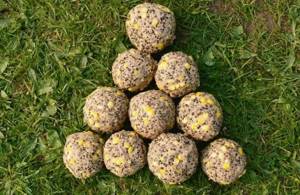
This procedure should be carried out directly on the shore, after which you can begin to catch bream. If the reservoir has a current, the recipe needs to be changed. Effective ingredients for a dish that attracts fish would be:
- sunflower cake - 200 g;
- bread crumbs - 100 g;
- pea sprouts - 200 g;
- oatmeal - 200 g;
- coriander - 3 tsp;
- clay - for binding ingredients.
Oatmeal should be boiled, the remaining ingredients should be added to the porridge and mixed thoroughly.
To the feeder
When the current is strong, the bait should have the maximum result, so fishing with a feeder excludes the use of cake or bran from the recipes. Any husk will quickly rise to the surface of the water, which can attract fry and impair the catch. The bait itself should be made viscous, which will allow it to sink to the very bottom intact, where its action will begin.
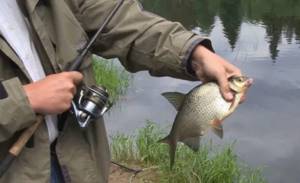
Fishermen use millet, which is suitable in viscosity and taste, as a nutrient base for bait. You can use live bait (maggots, worms, bloodworms). It is important to crush solid particles in the form of crackers as much as possible so that their color and shape can be similar to the bottom of the reservoir, otherwise the bream will not swim to the bait.
The best ingredients for feeder fishing for bream:
- breadcrumbs - 1 kg;
- millet - 200 g;
- oatmeal - 100 g;
- cookies - 300 g;
- sugar - 50 g;
- wheat bran - 300 g;
- corn flour - 100 g.
Video: Super effective feeder bait for bream
Before using the bait, the described ingredients must be soaked in water for 10 hours and left in the dark in a cool room. Then mix everything thoroughly, add water and clay to the mixture at the reservoir, and only then start fishing.
Making high-quality complementary food for bream, which will help you get large fish in large quantities, is possible only by experimenting with the composition. You should add a variety of foods that pique the fish's interest, but prepare the food carefully and thoughtfully. Start adding aromatic ingredients in minimal proportions, and then increase the dosage.
Making your own bait
Even fishermen who are not experienced in culinary matters can prepare working bait for catching roach. You just need to choose the appropriate mixture recipe.
Recipe No. 1
- steamed rye - 0.3 kg;
- crushed breadcrumbs - 0.3 kg;
- oatmeal - 0.2 kg;
- ground rolled oats - 0.1 kg;
- roasted ground hemp seed - 50 g;
- filamentous algae - 50 g;
- small maggot - 2-3 matchboxes;
- grated garlic - 0.5 tablespoon.
Recipe No. 2
- ground flaxseed cake - 0.2 kg;
- oatmeal - 0.2 kg;
- crushed clay - 0.1 kg;
- fried bran - 0.3 kg;
- young nettle - 50 g;
- lentils - 20 g;
- coriander - 1 pinch.
Recipe No. 3
- ground biscuit - 0.3 kg;
- breadcrumbs - 0.1 kg;
- dry crushed clay - 0.1 kg;
- bran - 0.1 kg;
- cumin - 1 pinch;
- small maggots and bloodworms - 2-3 matchboxes each.
Recipe No. 4
- steamed wheat - 0.3 kg;
- crushed breadcrumbs - 0.3 kg;
- ground pumpkin seeds - 0.2 kg;
- fried bran - 0.2 kg;
- thyme - 2-3 pinches;
- formic acid - 2-3 drops;
- tubifex - 0.2 kg.
A guide to fishing with a feeder - all the subtleties of preparing equipment and fishing techniques.
How to prepare bait for crucian carp - ingredients and flavoring (differences from bait for roach).
Carp bait - a detailed guide.
